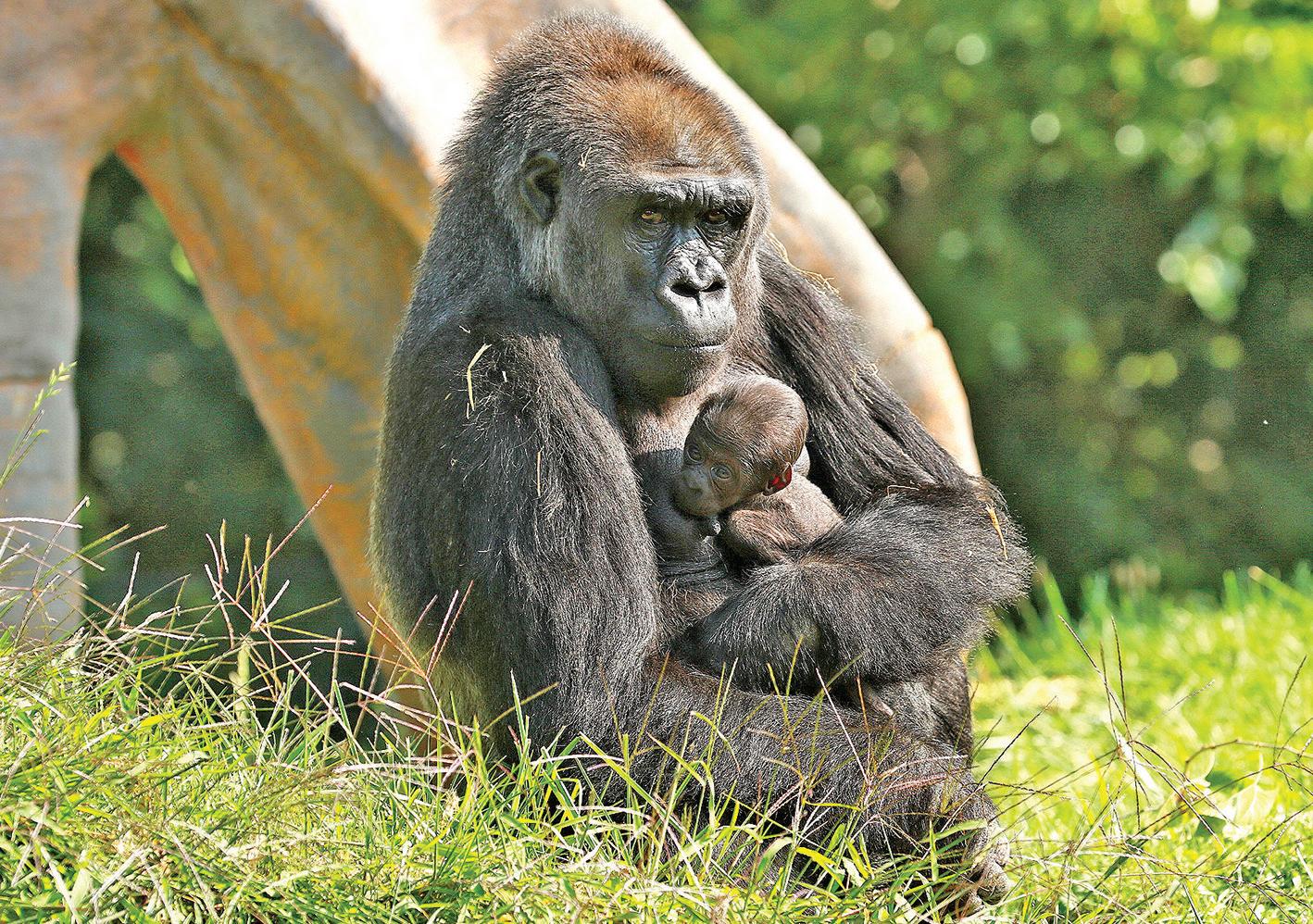NEWSPAPERS Special Edition











BY K. MICHELLE MORAN kmoran@candgnews.com
GROSSE POINTE CITY — Village visitors will be able to “fall” for art this September, as autumn starts on a bright note in the Grosse Pointe City business district.
Art Takeover will return for its second year, bringing original works to participating businesses. From Sept. 5 to 30, about 84 local artists will be showing their work at 35 Village stores and restaurants. Some artworks will be outside.
“We are really excited about the event,” said Art Takeover organizer Michelle Boggess-Nunley, owner of Posterity Art & Framing Gallery in The Village. “This year is even bigger and better. The goal is to create an identity for The Village.”
An opening night reception will take place from 5 to 7:30 p.m. Sept. 5 in The Village, with many participating businesses offering







BY TAYLOR CHRISTENSEN tchristensen@candgnews.com
ROYAL OAK — For the first time in the Detroit Zoo’s 96-year history, a baby gorilla has been born at it, and according to the zoo’s experts, the first few weeks of the baby gorilla’s life have been ideal.
On Aug. 26, the Detroit Zoological Society announced that the baby gorilla is a girl, and the public will help choose her name.
On the morning of Aug. 8, the baby girl was born to 26-year-old Bandia, a first-time mother. The father is 36-year-old Mshindi, and both are doing well as parents, according to Detroit Zoological Society mammal and primate teams.
Aaron Jesue, a member of the animal care staff specializing in great apes, said that the coming of this new baby was fast and surprising, being that it took a little less than a year for Bandia to get pregnant and have a baby.
Bandia, Mshindi, 11-year-old Nayembi and 20-year-old Tulivu, all arrived in August of 2023. Jesue said that the group has been acclimating well to the new addition.
“As soon as we saw that first pregnancy test — then we got another confirmation a couple weeks later, or maybe a month later — everything kicked into high gear,” Jesue said. “We were enjoying
See GORILLA on page 4A


















































BY ALYSSA OCHSS aochss@candgnews.com
ST. CLAIR SHORES — “Full House” stars Dave Coulier and John Stamos recently tested their knowledge on the famous game show “Who Wants to be a Millionaire” and brought home $125,000 each for their charities.
Coulier, who is a St. Clair Shores native and a Michigan resident of five years, donated the money to the Children’s Foundation and presented it at the Children’s Hospital of Michigan in Detroit on Aug. 8.
Coulier played Joey Gladstone and John Stamos played Jesse Katsopolis on both “Full House” and its sequel “Fuller House.” The lowest amount of money Stamos and Coulier could win was $32,000.
Coulier said he chose the hospital because he’s visited with the children, staff and parents over the years.
See COULIER on page 10A



BY NICK POWERS npowers@candgnews.com
CLINTON TOWNSHIP — The words don’t always come when someone’s alive.
Wind phones allow you to say those things through a telephone receiver connected to nothing in the living world. Clinton Township is set to get one, which will also be the first in Macomb County. The project was unanimously approved by the Clinton Township Board of Trustees at its Aug. 12 meeting.
Itaru Sasaki installed the first wind phone in Japan following the death of a family member in 2010, according to a Bloomberg News story. Wind phone booths have since popped up around the world.
The booths have no particular religious connotation and are private.
“When I first heard about this, I didn’t quite understand it,” Clinton Township Supervisor Bob Cannon said. “But, when it was explained to me, I liked it.”
Fran Badalamente, who represented the Senior Adult Life Center at the meeting, explained the importance of the phone.
“It is a lovely idea,” Badalamente said. “I really think that it’s something that would add to our center and the people that are going through the process of grief.”
The township’s senior center spearheaded the idea. The Lowe’s home improvement store, near the intersection of Gratiot Avenue and 15 Mile Road, and Dignity Memorial took care of the funding for the booth.
Township Trustee Julie Matuzak said this tribute was more environmentally friendly than things like lantern releases.
“This is the same concept but in a way that is both personal, because you’re talking on the phone, and it is more environmentally friendly,” she said.
Debbie Travis, assistant director for the senior center, said she hopes the community treats the space with respect.
“It should be viewed as a sacred space. It’s owned by everybody,” she said. “We’re all going to go through these feelings in our lifetime.”
Travis hopes the township’s booth normalizes the idea and helps put it in other communities. She said she plans to use the phone when her mom eventually passes.
“I’m guaranteeing her, I will be talking to her through it,” Travis said. “Our relationship will not end.”

it along the way, but it was a really good and fast turnaround from the point that they got here, the group was all together, doing great, and then boom, pregnant.”
For around 20 years, the Detroit Zoo took on the role of housing male apes, which they called a bachelor group. According to Jesue, the Detroit Zoological Society had one of the longest-running bachelor groups in the entire country.
The goal with bringing in the female apes was to ultimately mate Mshindi and have a baby born.
“It’s just such a cool, full-circle moment in only a year’s time, to where we were so used to working with the bachelor boys, we knew what to expect with them on any given day, and everything just completely changed a year ago, and it’s continuing to change,” Jesue said.
Tami Brightrall, associate curator of mammals for the Detroit Zoological Society, said that planning a gorilla pregnancy is a tedious and serious process.
Brightrall said there are around 350 gorillas in about 49 zoos in North America, and those gorillas are managed by a committee of people with the Association of Zoos and Aquariums. She said the committee works together to figure out the best pairings for gorillas for a genetically diverse gorilla population in zoos.
“Here at the Detroit Zoo, the recommendation was for Bandia to breed with Mshindi. It worked,” she said. “They like each other, and they have been together for years, not only at this zoo, but at another zoo as well, so it worked well.”
Having a gorilla family within the zoo is a positive and enriching experience for all the gorillas in the enclosure, according to Brightrall, and a big development for Bandia.
“The mother gorilla having a baby and caring for it is a really big part of their life. It’s a goal for them to breed and reproduce, so for them to fulfill that, it makes their whole life fulfilled,” she said. “It also makes Bandia experienced, so if she has another baby, we are going to know that this mother is really good, she pats the baby, she looks after the baby.”
As Brightrall said, Bandia is an excellent mother, which is backed up by Jesue, who said that this could have turned out to be very different. In some cases, the mother gorilla might not want to look after the baby, which would then be handed over to a surrogate mother to take care of it.
“When Bandia was born at the Pittsburgh Zoo, her mom was not a great mom. She didn’t take care of her the way that Bandia is taking care of her baby now, holding her and stuff,” he said. “We were worried that with her background and being in other groups where she did not really see a ton of other successful moms, that it wouldn’t click for her, she wouldn’t know.”
To help prevent this, the mammal team tried to train Bandia as best as possible before she gave birth, and helped to shape her into the mother she is today.
“Because of her background, we wanted to make sure that there were other options where we could encourage and help train her to know what she needed to do in certain situations,” he said. “So, what we would do for the maternal training is that I would carry a stuffed gorilla and show her how to hold it correctly, where it’s facing her body, so the baby could be the one to figure out if it needed a nurse.”
The team would also desensitize Bandia to the various ways a baby gorilla might touch her, pull her hair, mimicking the movements of a newborn baby.
The tests and training proved to be successful, as Bandia is a very protective and loving mother. She has shown no signs of wanting to disown the baby, and is seemingly content with her new role as a mother.
Brightrall said that the outcome of Bandia’s pregnancy is a testament to the commitment and care that the Detroit Zoological Society team has for its primates.
“They are willing to take risks and chances, appropriate risks and chances, but that is a very big deal that these primate keepers are so good at their jobs,” she said. “They were like, it might be scary, but let’s do it. It might be fast; let’s do it.”
The next phase in this process is for the baby gorilla to be named.
According to a press release, it will be up to the public to figure out what the baby girl will be called, in the form of a vote.
Voting opened Aug. 26, and each vote requires a minimum of a $10 donation. People can choose from one of the following names: Usala, Amateka, Mbere, Lobeke, and Motema.
Each name has a unique story behind it, Usala comes from the conservation corridor in the Democratic Republic of the Congo, and also means “forest” in Kikumu.
Amateka means “history” in Kinyarwanda. Mbere means “first” in Kinyarwanda. The name Lobeke comes from the national park in Cameroon, which is home to the highest density of western lowland gorillas in the world. Finally, Motema means

Waltonwood supports residents’ active and independent lifestyles and removes the worry that seniors — and their family members — often experience when they’re living on their own.
Move to Waltonwood and spend time doing things that make your happy. We’ll take care of the rest!
• Chef-prepared dining experiences
• A variety of Life Enrichment programs
• Personal care services available when needed
• Housekeeping services and home maintenance
• Scheduled transportation
things like refreshments and door prizes. In addition, Boggess-Nunley said there will be live music, street performers, a caricature artist and a performance from The Amazing Flec, a contact juggler.
“It’s a free event, so it’s a great way to get to know the community,” Boggess-Nunley said.
The artworks were selected from 125 entries.
“It was incredible,” Boggess-Nunley said. “We were very fortunate to have so many creative artists submit.”
Once again, visitors can try their hand at a scavenger hunt. Scavenger hunt participants can find a map to participating businesses in the Aug. 29 issue of the Grosse Pointe Times or inside the businesses themselves. Correctly answered scavenger hunt questionnaires will be entered into a drawing for prizes like art and gift certificates. A child-friendly scavenger hunt will be offered as well. BoggessNunley offered a tip for solving the questions by recommending that people follow the map from location 1 to location 35, saying the questions follow each other in numeric order.
Visitors are also encouraged to vote for their favorite Art Takeover work. The winner will receive a solo exhibition at Posterity.
While seeing the art and taking part in events like the scavenger hunt are fun for people of all ages, Art Takeover is meant to benefit Village businesses, too.
“It’s really a good way to bring people into businesses that maybe they’ve never been to before,” Main Street Grosse Pointe Executive Director Cindy Willcock said.
Last year’s Art Takeover did just that.
“It went well,” Boggess-Nunley said. “We brought in a lot of visitors to The Village. It was fun to see people walking around The Village with their maps.”
The artworks on view are available for purchase and Boggess-Nunley said they’re being sold commission-free, so artists will receive all the proceeds.
New businesses are popping up all the time, making a Village visit as exciting for longtime residents as it is for new ones.
“It’s really good that people are discovering — or rediscovering — our businesses,” Willcock said.
Posterity is located at 17005 Kercheval Ave. in The Village. For more about Art Takeover, visit posterityartgallery.com or call (313) 884-8105.
“heart” in Lingala.
The winner will be determined by the name that receives the highest donation amount. All donations will be going to the Saving Animals from Extinction Program. The program helps wild gorilla populations through on-the-ground protection of gorillas, research and monitoring, according to the zoo.
Voting will be open through Sept. 9, and members of the public can vote as many times as they want, with a $10 donation for each vote. The zoo will announce the winning name shortly after the contest concludes. People can find more information on the baby and voting at detroitzoo.org.






















































































































Louwers | (586) 498-1089 | brianlouwers@candgnews.com Annie Bates | (586) 498-1071 | abates@candgnews.com David Wallace | (586) 498-1053 | dwallace@candgnews.com Sports: Jonathan Szczepaniak | (586) 498-1090 |






































(586) 498-1099




| kboz@candgnews.com
Millar | (586) 498-1054 | lmillar@candgnews.com
Advertising: Paula Kaspor | (586) 498-1055 | pkaspor@candgnews.com
BY KARA SZYMANSKI kszymanski@candgnews.com
SHELBY TOWNSHIP — The Packard Proving Grounds Historic Site will be hosting a Rosie the Riveter Memorial Garden luncheon Sept. 22 and honoring Rosie the Riveters who contributed so much to America’s war efforts during World War II.
The Packard Proving Grounds is honoring eight Rosies who made a memorable impact. The eight include Jane Lusik, Bernice Palmer, Martha Oren, Helen Riley, June Tolan, Virginia Levy, Edna Leadford and Helen Endykewicz.
The proving grounds will be unveiling its Rosie the Riveter Memorial Garden that was recently planted to honor the memory of Packard Motor Car Co. “Rosies” who contributed to the war effort.
The program, titled “Heroes of the Home-front” will be presented by Debra Wake, who is currently the education and volunteer coordinator at the Holland Museum in Holland, Michigan.
Wake is a member of the American Rosie of the Riveter Association. She worked for 25 years at The Henry Ford Museum in Dearborn and retired in 2020 as manager of youth, family and camp programs. She is also the former


vice president of the Southeast Michigan “WOW” chapter of the American Rosie the Riveter Association and a former Tribute Rosie at the Yankee Air Museum, which is now the Michigan Flight Museum.
“As a member of the American Rosie the Riveter Association it is my honor to share the story of Rosie the Riveter. Through presentations, parades and appearances (at) public events. We promote the story of Rosie’s commitment to helping to win World War II and keeping the homefront running. We also do oral interviews to capture their personal stories and experiences. These women had moxie and determination, and this country could not have won the war without them,” she said.
She said that in her presentation, she shares not only the story of who Rosie the Riveter was, as promoted through music, posters, and newspaper and magazine articles, but also how the government created the largest advertising campaign to date to convince women to leave their homes and work in factories and other jobs to support the war effort,” she said.
Wake said the women in the Detroit area, which was known as the Arsenal of Democracy, came out by the millions and discovered that they could do it.




“My presentation will end with what happened to these women when the war was over and what the legacy of Rosie the Riveter means to all of us. I was also honored to be invited to attend the April 10 ceremony at the Capitol in D.C. where Rosie the Riveter received the Congressional (Gold Medal). There were 27 original Rosies, age range from 95 to 106, present to accept and finally be recognized for their contributions,” she said.
Wake continues to conduct oral histories, research and share the legacy of Rosie the Riveter.
Kim Parr, the curator at the Packard Proving Grounds Historic Site, said she is astonished at what these women did that
impacted the war so much.
“The things that these women accomplished were amazing and most likely had more of a profound effect on ending the war than what is realized. It’s inspirational, a story the younger generations should know about, and one that contemporaries can be proud of. A rosebush in our new Rosie garden, with a marker, will be dedicated for each of the Rosies we are honoring,” she said.
The Packard Proving Grounds Historic Site is located at 49965 Van Dyke Ave. Tickets to the event will cost $40. The luncheon will include chicken Marsala, penne pasta with palomino sauce, Santa Anna potatoes, green beans almondine, salad, rolls and dessert.
For more information and tickets, visit packardprovinggrounds.org/event/rosie-theriveter-garden-memorial-luncheon.














8A/SEPTEMBER 4, 2024

In this week’s Behind the Wheel, Staff Writer Maria Allard shares memories of the camping trips across the country she took with her family as a kid. The photos were taken in slide form in 1979 when the family traveled out West.
BY MARIA ALLARD allard@candgnews.com
METRO DETROIT — It was my first road trip, but I was a baby and don’t remember it.
At 6:15 a.m. on July 26, 1970, my family left our Warren home for a camping trip. The odometer read 40,313 miles and my parents had $497 in cash, plus a credit card. Destination: the California coast.
Do you own a vehicle with an interesting history? Contact Staff



Every summer my parents, two older brothers and I camped. We’d load up, pile into our Plymouth station wagon and head for the open road with an atlas and state maps guiding us. This was before GPS. Altogether, we camped in 48 states — never made it to Alaska or Hawaii — and parts of Canada.
My dad would have lived in a campground all year if he could. Me, ugh, I hated camping. It was torture: the bugs, no room for my bike, and I missed my friends back home. But the




TOP: One of our stops on our way to California. ABOVE LEFT: The 1972 Apache pop-up trailer was how we saw the country many times. ABOVE RIGHT: I believe this is Newport Beach, California. I loved the beach and still do.
LEFT: My family spent a day in Tijuana, Mexico. We drove from our camping site in southern California. Photos provided by Maria Allard
















worst part was no TV. That would be equivalent to being without an iPad or cellphone in today’s world.
Each vacation was planned out. We’d go out West, down South or just eastbound and down. We’d drive everywhere: big cities, the country, back roads, major highways. To pass the time, I read Mad Magazine and stayed on the lookout for Volkswagen Beetles.
I might have liked camping if we traveled in a cozy motorhome or shiny Airstream trailer. The first family trailer was basically a box on wheels. By the mid-1970s, my parents purchased a 1972 Apache popup trailer. It wasn’t one of those easy ones you crank and all the work is done. This trailer required all five of us to put it up and take it down. We’d all hold different poles and pieces of canvas until it was up. It always took forever.
My least favorite campgrounds were the primitive ones. But there were plenty of campgrounds we stayed at that had it all: a pool, game room, movie night, snack bar,
laundromat, and gift shop. The KOA’s were always nice. Sometimes we’d end up at a state park.
With each camping trip — from the mid-1960s through the late 1980s — my parents kept a journal, which I still have. They jotted down the date, mileage, which city and state we were in, the weather, what time we awoke, and people we met. My parents also wrote brief paragraphs about the places we visited. For instance, during our 1974 trip to Yellowstone National Park and the Grand Canyon, we ran into boxing legend Joe Louis at Caesar’s Palace in Las Vegas.
“He said ‘I want to shake hands with these little ones,’” Mom wrote. “When we told him we were from Detroit, he said, ‘Say hello to Detroit for me.’ He looks good.”
Even though camping wasn’t my thing, I loved traveling. The trips that really came alive for me were California in ’77 and ’79, Virginia Beach in ’78, and our 1980 journey through Toronto, Montreal, upstate New York, New York City and Atlantic City.
On off-road days we’d go somewhere: a museum, a tour, a hall of fame, a historic site, a landmark, a cathedral or a ballpark.
My parents made sure to have one amusement park on the itinerary.
Another great thing was meeting kids from all over. We’d visit each other’s campsites, swim or play pool in the game room. If I had to pick a favorite spot or two, it would be the eastern and western shorelines. There was nothing like being on a Pacific Ocean or Atlantic Ocean beach. I still long for swimming with the waves while smelling saltwater in the air.
The Virginia Beach, Virginia, campground stands out. It was huge with so much activity. Every morning a man drove through yelling “Doughnuts, fresh doughnuts!” from a truck, and every time I went into the game room, Welsh singer Bonnie Tyler would belt out “It’s a Heartache” on the jukebox.
When we experienced car trouble in a small West Virginia town, the only mechanic was out for the day. Stuck, we set up camp somewhere. As dusk fell, the mechanic found out about us and invited my brothers and me back to his house to stay overnight with his wife and kids. His large family reminded me of “The Waltons.” They were so kind. We sat around the kitchen table, had snacks and talked. It was the first time I ever
had Country Time lemonade.
I always remember where I was Aug. 16, 1977, when news broke that Elvis Presley died at his Graceland mansion in Memphis. We were getting ready to go to the San Diego Zoo while Dad sat at the picnic table listening to his handheld Panasonic radio.
“Elvis died,” he said, looking up at us.
On our way home, we stopped in Memphis. Fans mourning the singer’s death gathered on Elvis Presley Boulevard. Dad picked me up so I could see Graceland. This was before it was open to the public. The house looked big and so far away in the distance.
My parents are no longer living. I am so glad they took us on all those trips. We saw so much: the Liberty Bell, Mount Rushmore, Colorado’s Rocky Mountains, Redwood National Parks, Dealey Plaza in Dallas where President John F. Kennedy was assassinated, the prairie dogs in Montana, Fisherman’s Wharf, Dollywood, Bob Evans’ original farm in Ohio and more.
A neighbor with two kids bought the trailer at my parents’ estate sale. I hope they got out of it as much as I did. I would not trade the experience for anything. I wish I could do it all over again.

















page 3A
“It’s a phenomenal place and they’re doing phenomenal work,” Coulier said.
Winning the money was no walk in the park. Coulier said it was quite difficult to answer the questions correctly. He said no one knew the $500,000 question Stamos and Coulier stopped at. They opted to not answer the question and took the money from the last question they answered correctly, which was $250,000.
The $500,000 question was this: “Since he reportedly hated the name ‘Scarface,’ Al Capone’s inner circle called him by what name, slang for stylish.”
The correct answer was “Snorky.”
“It was a really fun game to play,” Coulier said. “I got to be with my brother John Stamos. But it was hard. We ran out of lifelines.”
Players receive a series of lifelines to give them an advantage in answering a difficult question. Potential lifelines include “Phone a Friend,” “Ask the Audience” and more.
Coulier received the call about the game show around eight weeks prior to the presentation.
“Then I found out that I was going to be on with John Stamos and I said, ‘Alright, game on, let’s do it,’” Coulier said.
Children’s Hospital was the only place he thought of to donate the money.
“It was really the No. 1 choice and the only choice, so it was a really easy decision to make,” Coulier said.
Archie Drake, CEO of the Children’s Hospital of Michigan, said he knew about the money before Coulier donated it, saying the celebrities had to indicate which charity they chose.
“I was aware we would be the recipient. I didn’t know how much it would be,” Drake said
Drake said he has watched the show before and that he has answered one or two of the questions right. He learned the amount of money around two weeks prior to the presentation. He said he was excited about the donation.
“At first I was humbled that Dave chose this hospital to be (the) recipient of his generosity,” Drake said.
He wanted to share the celebration and excitement with hospital staff and patients. Some of the staff as well as some patients met Coulier when he presented the check.
“It truly isn’t about me, it’s about them,” Drake said. “And the fact that they can share in this phenomenal gift just touched my heart.”
Drake said Coulier stopped by the hos-

pital before he won the money and that the actor is part of the family.
“He’s not new to us, we’re not new to him,” Drake said.
Rick DiBartolomeo, vice president of finance at the Children’s Foundation, said their foundation represents the hospital when it comes to donations.
“The proceeds go actually to the Children’s Foundation and then we put it towards youth, whether it be research, grants and so forth to the children’s hospital,” DiBartolomeo said.
Ashley Ashkenazi, development director at the Children’s Foundation, said the entire staff watched the episode featuring Coulier. Though there were no watch parties: everyone watched at their homes and texted each other.
DiBartolomeo said the money will go directly into research and Ashkenazi said some of the money will also go toward improving the lives of patients.
“Making sure that kids have as normal of a childhood, even as they are patients,” Ashkenazi said.
The services include supplying therapy and making sure teachers are available to the patients.
DiBartolomeo said he thinks the future of the hospital is looking great.
“Unfortunately, we continue to see children being affected with diseases and the like, but it’s great to have such a worldrenowned hospital as we have here right here in the city of Detroit,” DiBartolomeo said.













































